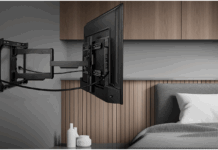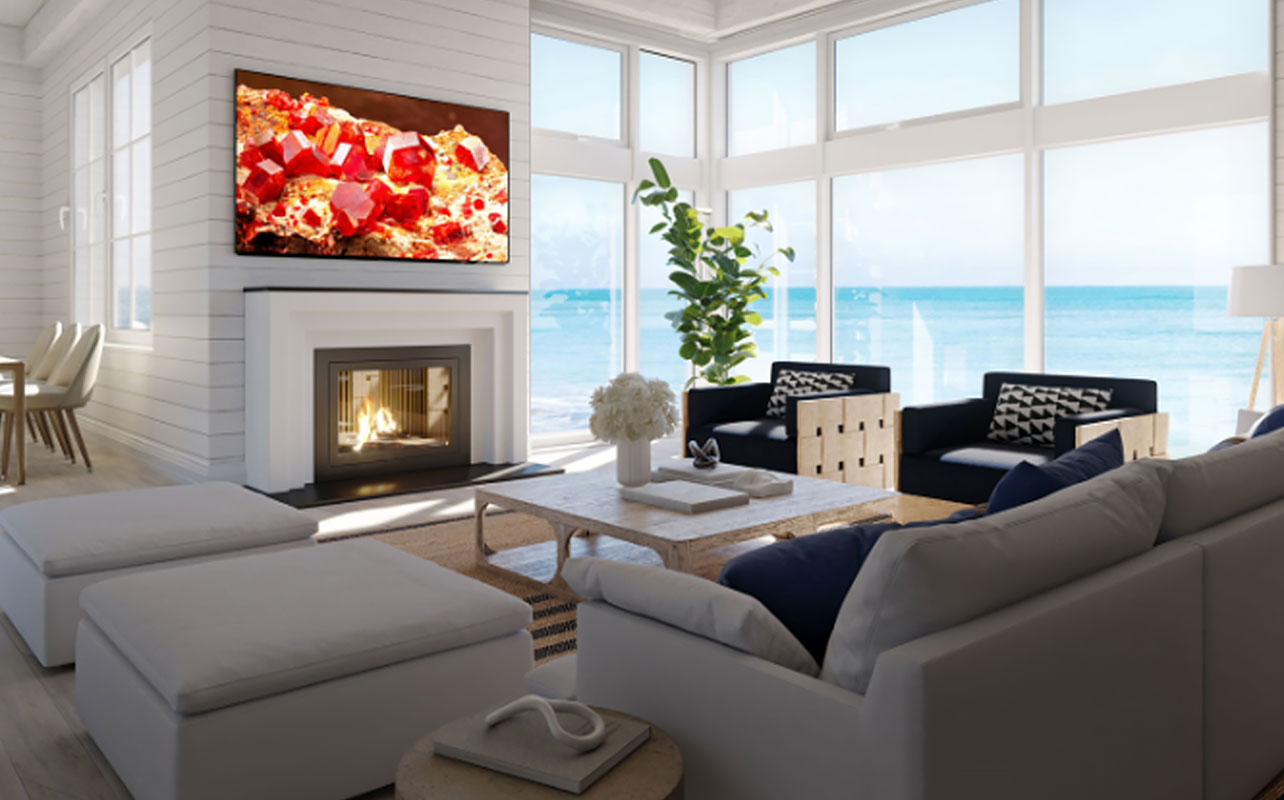
Wall mounting your TV can instantly elevate your space, whether you’re setting up your TV in the living room, basement theatre, or bedroom. By freeing up floor space and minimizing clutter, wall mounts create a clean, modern TV setup that enhances your viewing experience. But, how high you should mount your TV? The answer to the question is not just about aesthetics—mounting too high can strain your neck, while too low can disrupt your room’s layout.
This TV setup guide breaks down everything you need to know about how high to wall mount a TV, including general tips, height-by-TV-size recommendations, room layout considerations, and the perks of using adjustable mounts.
General guidelines for TV mounting height
The golden rule is simple: the centre of the screen should be at eye level when you’re seated comfortably. That means no craning your neck or slouching to find the sweet spot. Here are a few key details that are easy to overlook, but they can make a big difference:
TV type
The TV type plays a big role. Wall-mounted TVs generally need to be placed lower on the wall than TVs on stands. Why? Most TV stands already elevate the screen by several inches, which means the centre of the screen naturally ends up closer to your seated eye level. When you’re mounting a TV directly on the wall, you’ll need to get the precise height. It’s also worth noting that ultra-thin wall mounts, while sleek, offer less leeway for adjusting after installation. So it’s extra important to get the height right from the get-go.
Eye-level viewing angle
Ideally, your eyes should meet the middle of the screen or just below it when you’re sitting comfortably. This ensures a neutral neck posture, which becomes especially important during long viewing sessions. A slight upward tilt is generally okay, especially if you’re lounging on a recliner or lying in bed. But too much tilt (like what you’d get from a screen mounted too high) can lead to an uncomfortable viewing experience.
Screen glare
Take a good look at the light sources in your room, including nearby windows, overhead lights, and table lamps. If any of these reflect off your TV screen, it can wash out the image and cause eye strain. Choosing the right mounting height—and potentially adding a tilting or swivelling mount—can help minimize those reflections and give you a clear, vibrant picture every time you watch.
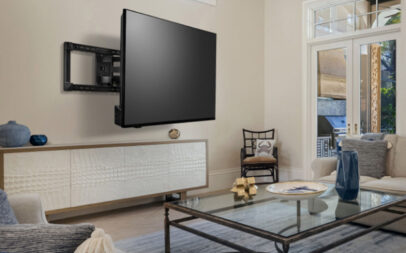
Ready to wall mount your TV?
If your planning to take the DIY route for mounting your TV, this guide has you covered. From choosing the right type of mount to getting it installed safely and correctly, we’ll walk you through each step of the process.
Ideal TV mounting height by TV size
How high you should your place TV could depend on the TV size. What works for a 43-inch screen won’t cut it for a 70-inch model. The table below breaks down the common sizes and their ideal mounting height. Based on typical seated eye levels and average screen dimensions, the mounting height refers to the distance from the floor to the centre of the screen.
| TV size | Mounting height |
| 43-inch TV | 56 inches high |
| 55-inch TV | 61 inches high |
| 65-inch TV | 65 inches high |
| 70-inch TV | 67 inches high |
Remember, your space might be a bit different. Always double-check your measurements based on your own seating height and layout.
Pro tip: If you’re mounting above a fireplace (we know, it’s tempting), make sure the screen isn’t too high. Unless your fireplace is unusually low, you may need a tilting mount to bring the screen to a more comfortable angle.
Considering room layout and seating distance
Here’s where things get personal. Your room layout, furniture, and even where you tend to sit all play a role in how high to mount a TV on the wall.
- Room layout can subtly influence how your TV should be positioned. In a traditional living room where all seats face the TV head-on, centring the screen at seated eye level is easy. But if you have an open-concept space, sectional seating, or a corner setup, you might need to adjust the height or angle to ensure everyone gets a comfortable view. Wall structure also matters—some walls may have windows, fireplaces, or shelving that limit where you can install the mount, so flexibility in height becomes even more valuable.
- Seating distance is another factor to keep in mind. If you typically sit close to the screen, say within five to seven feet, then mounting your TV too high can create a harsh upward viewing angle, which becomes uncomfortable during long movie marathons. But if your seating is farther back, like in a large living room or media space, you have a bit more flexibility to mount the TV slightly higher.
Ultimately, achieving the right balance is key. First, measure the distance from your seating position to your eyes, then assess how far you are from the screen while keeping your usual viewing habits in mind. This combination will guide you to determine the ideal mounting height for your specific setup.
Pro tip: Follow these steps to test out the TV height before drilling holes.
- Use painter’s tape to mark the proposed height on the wall.
- Cut out a piece of cardboard roughly the size of your TV and tape a piece of reflective material like a plastic wrap or a clear file folder.
- Stick the cardboard up at that height. Then sit down and test it out. Does it feel natural? Is it comfortable to look at for a long time?
- Check for glare by turning on the lights or opening the curtains.
Adjustable mounts for flexible viewing
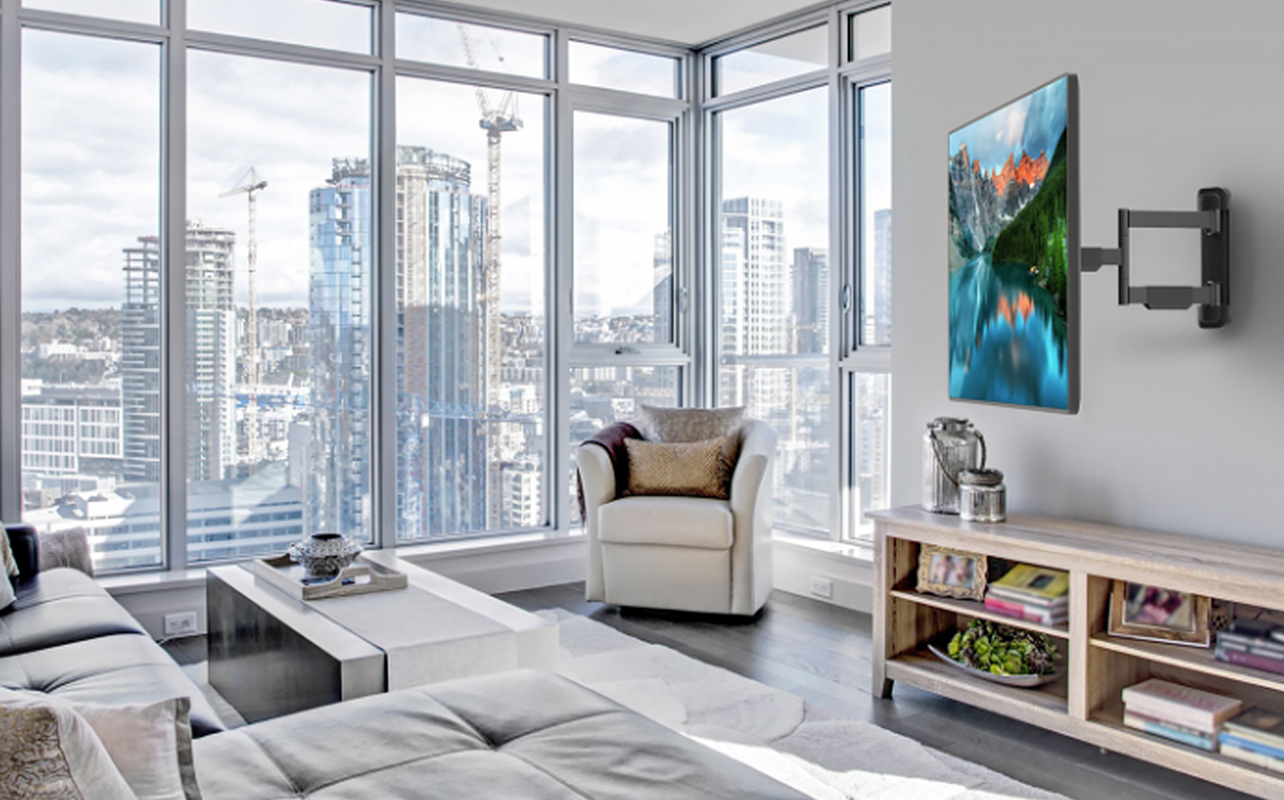
Adjustable mounts are a game-changer. These mounts add a layer of flexibility that fixed brackets just can’t match. Beyond flexibility, adjustable mounts also help with reducing screen glare and make it much easier to access HDMI ports, power connections, and streaming devices without needing to unmount the entire unit. They’re especially helpful in rooms where layout and lighting aren’t always predictable.
Tilting mounts
If your TV needs to be mounted higher than recommended, like above a fireplace mantel or on a high bedroom wall, consider titling mounts. They let you angle the screen downward, so you’re still looking straight ahead rather than craning your neck upward. It’s a small adjustment that makes a big difference in comfort, especially during long binge-watching sessions.
Swivelling mounts
They’re ideal for multipurpose or open-concept spaces. Let’s say you’ve got a kitchen island or a reading nook off to the side of your main seating area. With a swivelling mount, you can turn the TV toward wherever you happen to be without compromising picture quality or straining to see the screen.
Full-motion mounts
Full-motion mounts offer the most versatility of all. These mounts allow you to extend the TV away from the wall, tilt it up or down, and swivel it left or right—all in one go. They’re perfect if you rearrange your furniture often, share a space with people who have different viewing preferences, or just like having options.
Use the table below to compare the three main types of adjustable TV wall mounts, based on features, ideal use cases, and the kinds of rooms they work best in.
| Mount type | Best for | Key features | Room/layout fit |
|---|---|---|---|
| Tilting mount | TVs mounted higher than seated eye level (e.g. above fireplace or in bedroom) | Tilts screen downward for better viewing angle | Bedrooms, living rooms with high mount points |
| Swivelling mount | Watching from multiple angles or spots in the room | Swivels side to side for flexible screen positioning | Open-concept layouts, kitchens, multi-use living spaces |
| Full-motion mount | Maximum flexibility and adjustable setups | Extends, tilts, and swivels for complete viewing control | Frequently rearranged spaces, shared viewing environments |
Professional installation services from Best Buy
Not everyone wants to spend their weekend with a level, drill, and manual in hand. If DIY isn’t your thing, consider the TV mounting services from Geek Squad. Its team of TV installation professionals provide
- Expert help determining how high to place your TV based on your room layout, screen size, and seating.
- Secure installation to wall studs, so you can rest easy knowing your TV isn’t going anywhere.
- Cable management solutions to keep things clean and clutter-free—no more dangling cords ruining your minimalist setup.
- Optional in-wall cable routing for a seriously sleek look.
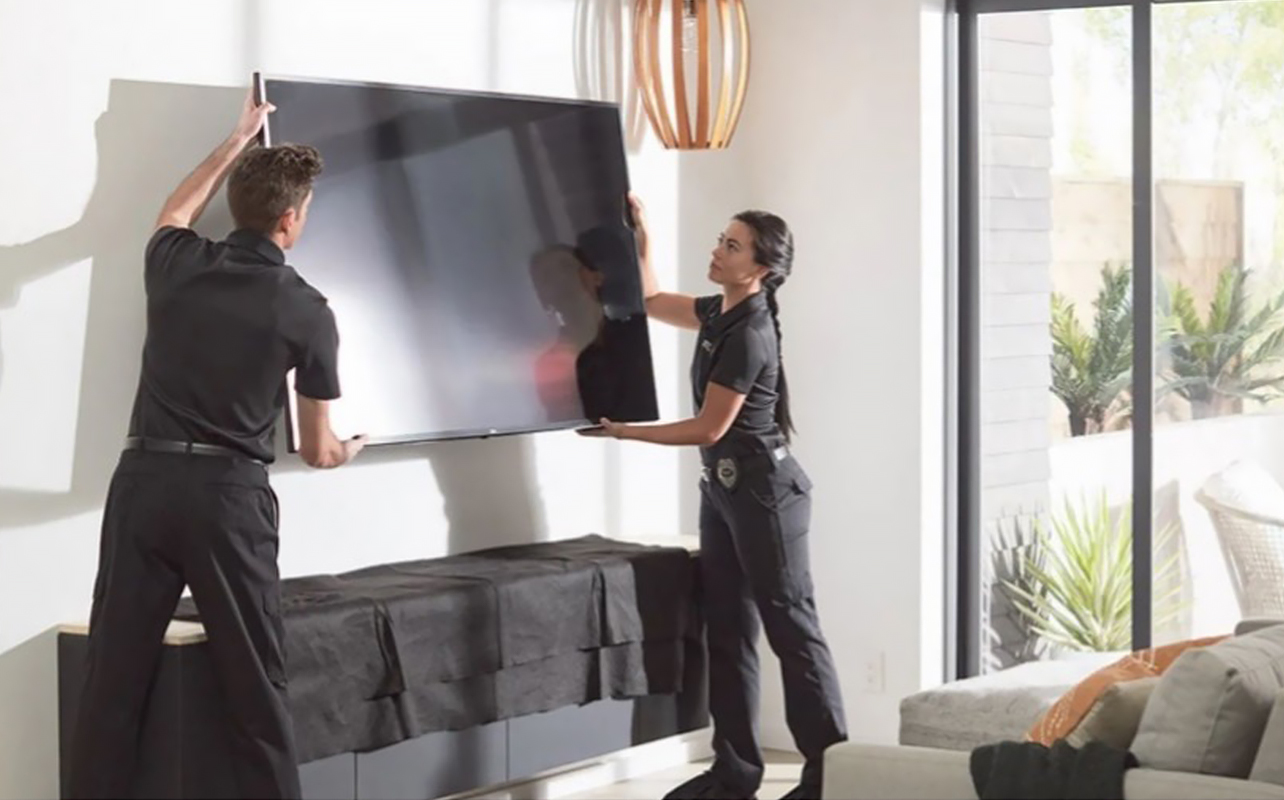
Mount your TV with confidence
Figuring out how high to wall mount a TV isn’t one-size-fits-all. Find what works best for your space and focus on a few key things: your seated eye level, screen size, and room layout. Aim to centre the screen at eye level when seated and use the TV size guide as a starting point. Then adjust based on your couch height, seating distance, and any light sources that could cause glare. If you want more flexibility, adjustable mounts are a great upgrade—they help with angles, glare, and even give you easier access to cables.
Explore a wide range of TV mounts at Best Buy Canada. Whether you’re going full DIY or booking a Geek Squad expert, your perfect setup is just a few clicks away.
This article was drafted using AI technology and then reviewed, fact-checked, and revised by a member of our editorial team.



